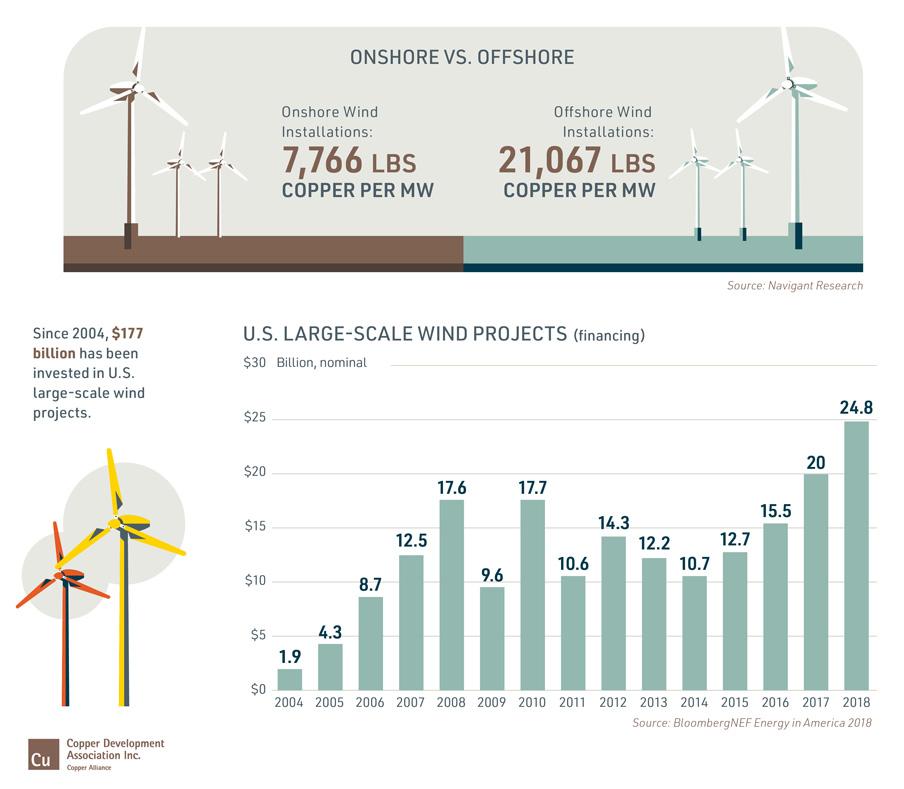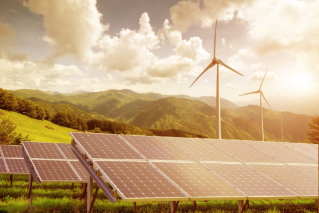
Commercial, industrial and utility sectors are installing solar photovoltaic panels and building high-megawatt wind farms to generate clean, efficient power to meet our rising energy demands. These energy sources are plentiful and do not continuously generate carbon or other emissions.
Videos
 Oak Creek Wind Energy
Oak Creek Wind Energy
Oak Creek Energy Systems Inc. is a pioneer in gigawatt-scale wind energy with its long-term expansion of wind power capacity in the Tehachapi-Mojave area of California. This video describes a somewhat unique case where one wind farm was constructed to serve one major customer, and explores the infrastructure necessary to keep the turbines up and running.
Education
- Infographic- The Impact of Copper [ PDF-1.7 Kb] Copper is critical to our lives and communities today and will continue to be integral as we move toward sustainable energy resources in the future.
- Infographic - Copper's Role in the Transition to Clean Energy [PDF - 1Mb] This new infographic illustrates copper's expanding role North America's transition to clean power sources, from renewables, like solar and wind, to storage and electric vehicles.
- WIND: North American Wind Energy Copper Content Analysis [PDF] This report analyzes copper’s growing use for renewable wind energy through 2027. Between 2018 and 2027, it’s estimated 48,721 MW worth of wind energy installations will be constructed with an estimated demand of 4.76 tons of copper per MW.
- SOLAR: North American Solar PV Copper Content Analysis [PDF] This report presents a forecast for the North American solar PV market through 2027. Between 2018 and 2027, North America is expected to install 137 GW of residential and commercial & industrial solar capacity as well as 125 GW of utility-scale solar. This forecast also estimates during the same timeframe nearly one million tons of copper will be needed for this growing technology.
- Current and Projected Wind and Solar Renewable Electric Generating Capacity in the Domestic Market The Copper Development Association conducted a study and examined renewable energy (RE) production, including land-based and offshore wind; residential, commercial and utility-scale photovoltaic installations; concentrating thermal-solar electric plants; and geothermal plants.
- Thermal Modeling of Electrical Conductors with Emphasis on Solar Heating [PDF - 205Kb] This short white paper by John Paschal, Jr., P.E. of Paschal Engineering, explains the basic principles of conductor temperature in sunlight and emphasizes the importance of Table 310.15(B)(2)(c) in the NEC.
Case Studies
- Demonstrate Your Company’s Leadership in Wind or Solar Installation
CDA is looking for case studies on use of copper in wind or solar installation, or the use of copper in grounding for site safety. - SOLAR: Solar Energy Lifts Off at Airports Around the Globe [PDF]
Airports are a perfect location for solar PV installations. Multiple airports around the world have already installed solar energy systems, which require copper to function efficiently and reliably. This case study examines the solar airport trend and its potential impact on the copper market. - WIND: Copper and Wind Energy: Partners For a Clean Environment
Wind energy is growing at a very fast pace due to increased interest in renewable resources as the cost of fossil fuels rises, and copper plays a vital role in making that happen. Austin Energy is one utility that is taking dramatic steps to ensure that wind, and other renewables, are a big part of their energy mix. - WIND: Driving America to Energy Independence, 30-mph Wind + Plug-In Hybrids = 100 mpg
 Austin Energy Plug-in-Partners Campaign
Austin Energy Plug-in-Partners Campaign
Austin Energy had an unusual idea: convert and store nighttime wind energy to daytime gasoline. This article explores the concept behind Plug-in Partners, and how Austin Energy is approaching the idea of utilizing Texas' abundant wind energy. - SOLAR: 100 Miles of Copper Cable Connects, Protects 4.6-MW Photovoltaic Solar Farm
 Springerville Generating Station Solar Array
Springerville Generating Station Solar Array
Solar photovoltaics are one aspect of sustainable electric generation, and Tucson Electric Power is on the leading edge of this industry. The Springerville Generating Station solar PV installation is a prime example. This case study explores the PV installation in detail, including extensive use of copper to make the project possible.
Solar
Copper's electrical and thermal conductivity and high resistance to both atmospheric and aqueous corrosion makes it so valuable in solar energy systems.
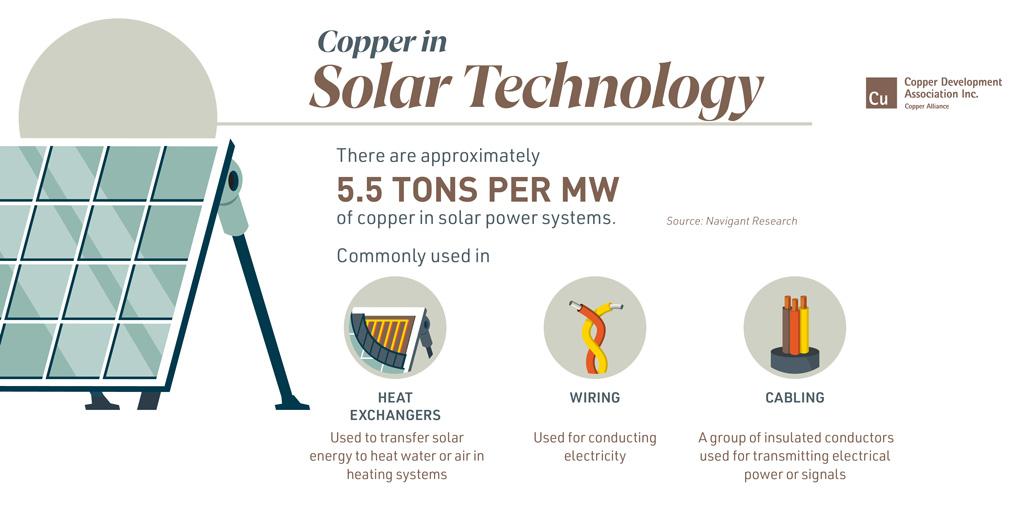
Solar PV by the Numbers
Solar power systems can contain approximately 5.5 tons of copper per MW. Copper is in the heat exchangers of solar thermal units as well as in the wiring and cabling that transmits the electricity in photovoltaic solar cells.
It is projected that 262 GW of new solar installations between 2018 and 2027 in North America will require 1.9 billion lbs. of copper.
Solar is the third-largest renewable energy source in the United States power sector. [Source: EIA]
4,700%: the increase in U.S. solar generation between 2008 and 2018. [Source: EIA]
The top states using solar energy are California, North Carolina, Arizona, Nevada and Florida. [Source: SEIA]
10,864,545: number of U.S. shipments of photovoltaic modules in 2017 [Source: EIA]
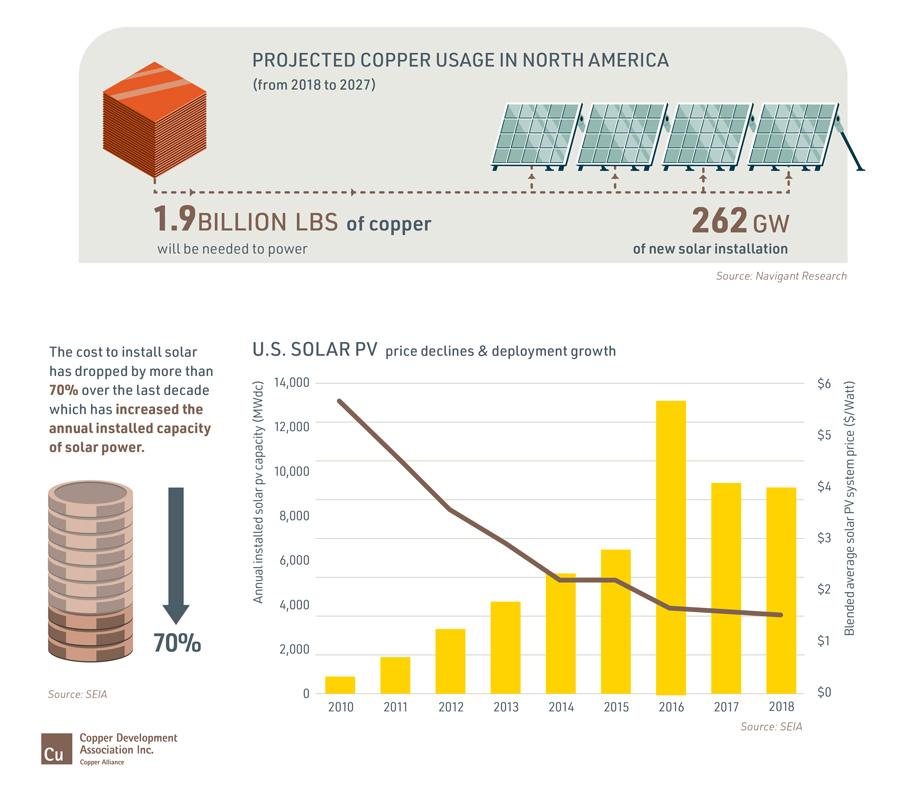
Wind
Copper is vital in wind energy technologies including in the electrical grounding system for wind turbine farms.
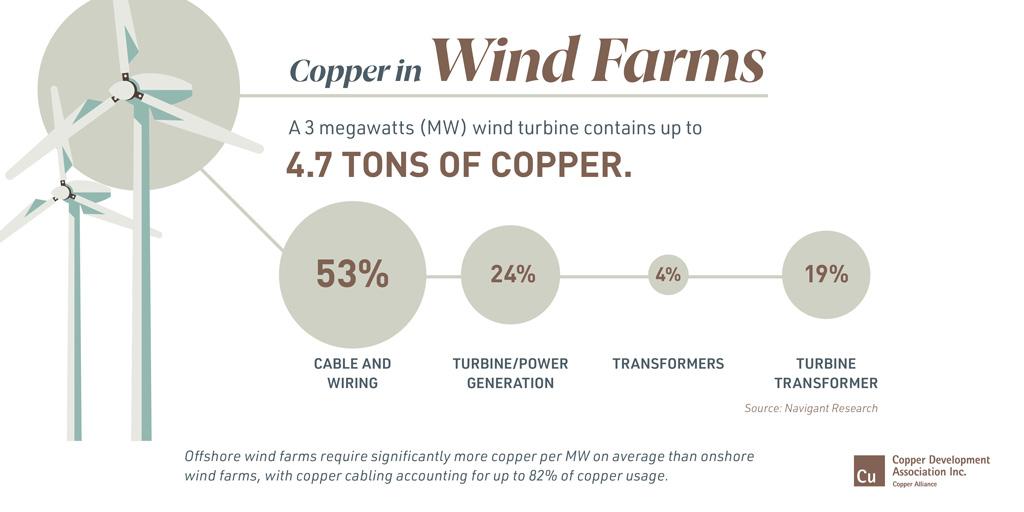
Wind Power by the Numbers
A three-megawatt wind turbine can contain up to 4.7 tons of copper with 53% of that demand coming from the cable and wiring, 24% from the turbine/power generation components, 4% from transformers, and 19% from turbine transformers.
Onshore wind farms use approximately 7,766 lbs. of copper per MW.
Offshore wind installation uses 21,068 lbs. of copper per MW. The cabling of the offshore wind farms accounts for the bulk of the copper usage.
6.5%: percentage of the country’s electricity generated by wind energy in 2018, enough to power 26 million homes. [Source: American Wind Energy Association]
8%: the capacity growth wind energy had in 2018 alone.
